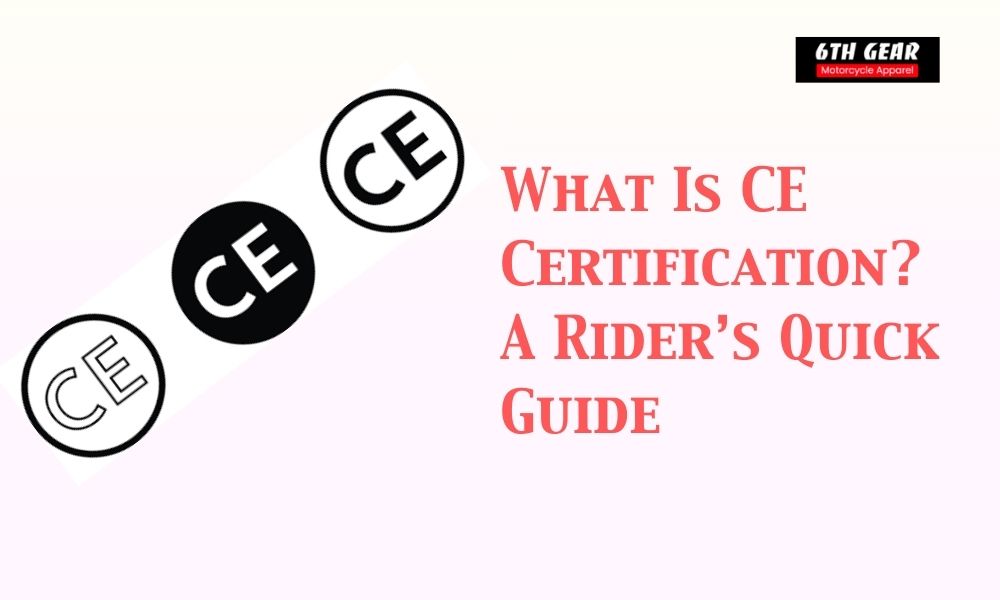What Is CE Certification? A Rider’s Quick Guide

Every rider knows the thrill of hitting the road. The sound of the engine, the rush of wind, and the sense of freedom are unmatched. But there’s another side to riding: safety. You may own a sleek jacket or a tough pair of boots, but the real test comes when things go wrong.
Will that gear hold up in a crash? That’s where CE certification motorcycle gear becomes more than just a label. The CE mark shows that the gear has been tested under strict European safety standards. It tells that the equipment isn’t just stylish but built to protect. Without it, it is a gamble every time you plan to ride.
What Does CE Certified Mean?
The answer to what does CE certified mean, is quite straightforward. It means that jacket, gloves, pants, or helmet has been pushed through tests like:
- Impact resistance – Can it absorb shock in a crash?
- Abrasion resistance – Can it handle sliding on asphalt?
- Tear resistance – Will the material rip apart under stress?
If the gear passes, it earns the CE mark. That way, riders know they’re buying more than just good looks—they’re buying protection backed by standards.
CE Approved vs. CE Certified
There’s often confusion between “approved” and “certified.” The CE approved meaning or something like “CE approved means” it complies with European safety requirements. But CE certification motorcycle gear is a stronger term. It means the product has been officially tested and documented.
In simple words:
- Approved = Recognized as compliant.
- Certified = Tested, proven, and officially verified.
What Does CE Rated Mean?
Even if gear is certified, you’ll still notice ratings. So, what does CE rated mean? It’s about levels of protection.
- Level 1: This is the basic level. It offers minimum protection but is lighter and more comfortable. Gear like Summer Mesh Jackets usually carries Level 1 because riders wear them in hot weather where comfort matters.
- Level 2: This is higher protection. It absorbs more impact and withstands more abrasion. This rating can be found in heavy-duty gear like Solid Textile Pants and reinforced boots.
Both ratings protect riders, but choosing between them depends on your riding habits.
How CE Certification Helps Riders Daily
On hot afternoons, riders often prefer Summer Mesh Jackets. They’re airy, flexible, and easy to wear. Thanks to CE testing, these jackets aren’t just breathable, but they’re abrasion-tested too. You stay cool without sacrificing basic protection.
For long-distance riders, Solid Textile Pants are a better match. They’re tough, weather-resistant, and tested to handle high-speed slides. Add in CE-certified boots, to enjoy a combination built to reduce injuries to the legs and feet.
CE Levels and Choosing the Right Gear
Not all riders need the same level of protection. Understanding ce levels can help with choosing wisely.
- City commuters: If you’re riding short distances daily, Level 1 gear may be the best pick. It’s easier to wear and doesn’t feel too heavy.
- Highway or touring riders: Long trips mean higher speeds, and crashes can be more severe. That’s where Level 2 gear shines. Yes, it’s heavier, but the added protection is worth it.
- Adventure riders: Off-road or mixed terrain requires gear that’s durable, waterproof, and impact-tested. Here, combining Level 2 pants with protective boots is often the safest choice.
When shopping, always check:
- Is the gear CE certified?
- What’s the ce rating for motorcycle gear?
- Does it suit your riding conditions?
These questions save us from buying gear that looks tough but fails in real-world riding.
Why CE Certification Matters Beyond Europe
CE testing is used by brands all around the world to demonstrate that the products they sell fulfill international safety standards. Therefore, when you see the CE label, it indicates that it has passed one of the most stringent testing methods available. That’s why riders everywhere rely on CE certification motorcycle gear.
Real Examples Riders Face
Imagine sliding on asphalt after a sudden brake. A non-certified jacket may tear within seconds, leaving the skin exposed. But a CE certified Summer Mesh Jacket, even though light, is designed to resist abrasion for critical seconds—enough to reduce injuries.
Or picture a touring trip. Without Solid Textile Pants, a crash at highway speed could shred basic fabric. CE-certified pants, tested for tearing and impact, provide real protection to the leg. Add sturdy, certified boots, and your feet stand a much better chance of avoiding fractures.
Clearing Common Misconceptions
Understanding the ce certified meaning and ce approved meaning can save bikers from believing myths that can put safety at risk. For instance:
- “CE gear is too heavy.” Not always. Modern CE-certified gear balances safety with comfort. Lightweight materials now pass Level 1 testing.
- “Only racers need CE levels.” False. Accidents can happen even at 30 mph in city traffic. CE-certified gear matters for every rider.
- “All gear is safe if it looks strong.” Wrong. Without CE testing, there’s no proof it can handle a crash. Looks don’t equal safety.
Final Thoughts!
Riding is about freedom, but freedom doesn’t mean ignoring safety. Knowing what does CE certified mean, what does CE rated mean, and how ce levels work helps you make smarter choices. Whether you pick light Summer Mesh Jackets, durable Solid Textile Pants, or strong boots, always check for the CE mark.
A gear isn’t just clothing—it’s your armor. And with CE certification motorcycle gear, know that armor has been tested, rated, and trusted by riders worldwide.
To find the gear that combines comfort, style, and tested protection, check out Six Gear for options designed with riders in mind.
















